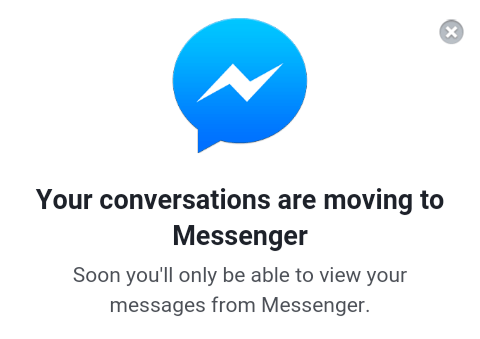
Facebook is removing the messaging capability from its mobile web application, according to a notice being served to users: “Your conversations are moving to Messenger,” it reads. Welcome news to the millions like me who switched to the web app in order to avoid Messenger in the first place!
At the moment, you can just dismiss the notice and go about your business. But this summer the warning will become an impenetrable wall, and your only option will be to download the official Messenger app.

I’m a little worried about this, because surely the mobile site is much used by people who have good reason not to download the app. People whose phones don’t have official clients, for instance, or who can’t upgrade to the latest version of an OS, and must access via the web.
And really, it strikes me as quite a hostile move, as it did before when they axed messaging from the main app. If, as everyone in the company is constantly repeating, mantra-like, that they want to connect the world, shouldn’t a diversity of access options be part of that?
The usual excuse, which I am expecting to receive at any moment from Facebook PR, whom I contacted for details, is that the company wants to provide the best possible experience in messaging, and the Messenger app is the platform on which they’ve chosen to provide it — so to avoid confusion they’re consolidating everyone there. (Update: that’s totally the statement I got, it even said “best experience”)
I don’t think a single person has ever bought that particular load of horsefeathers. It’s pretty plain for anyone to see that it’s easy to embellish, enrich and, of course, monetize a powerful platform like Messenger, while it’s near-impossible to do so with basic text-based chat.
In other words, one service provides valuable utility to users, but not to Facebook. Can’t have that!
There are differences in the core experiences of the desktop and mobile versions of Facebook — that’s okay! It’s perfectly fine that posts look different, you interact with things differently and certain features are absent or less easily accessed. This should be the case with messaging. Just offer plain text chat, for god’s sake, and quit it with this reach creep. Your users will thank you, and it’s really not going to hurt Messenger’s growth.
By all means, advertise Messenger on top of the message feed, or point out that some content will be missing. Messenger is more full-featured! You can do video, and stickers! Look, chatbots! But the decision to switch should be the user’s. By removing that agency, Facebook erodes a trust it should be tending to carefully.
And one more thing while we’re at it. Let us download Facebook Lite (where messaging still works, by the way)! This geo-restriction BS has got to go. Some of us have the phone equivalent of trash fires and don’t want to run that pair of hogs you call official apps.
Comments
Post a Comment